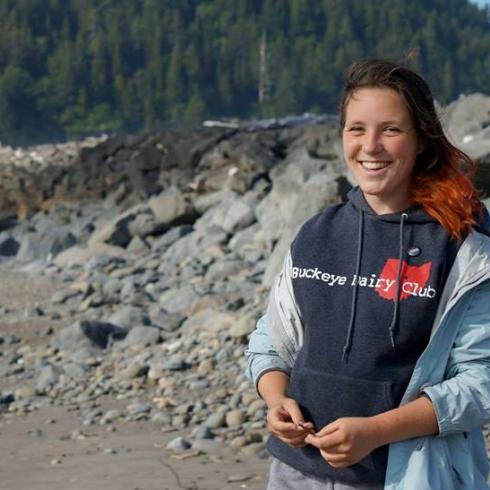It started the night before, when I called seven taxi companies twice each. No answer. My host brother tried, then my host mom. We finally decided my host dad (the only one not present at the time) would be in charge of dropping me off the next morning at 5:30am. (Sound familiar, Dad?)
My classmates and I met at school and bussed to the airport for a 30-minute plane ride to Coca. We arrived at the airport’s only gate. We then rode a bus to a nearby hotel on the Napo River, where we waited. The group watched horrendous Latin American soap operas while I tried to identify swallows.
The hotel was creepy and looked about twenty years past its prime. A pet squirrel monkey, taken illegally from the rainforest, picked our pockets for food. A peacock strutted in circles.
From here, we boarded a motorized canoe for a long, noisy ride down the Napo. The wide river reflected blinding sunlight and the speeding canoe sprayed welcome water on our arms. We spotted an oil well with eerie orange flames dancing from its two towers. I felt like a hobbit from The Lord of the Rings, slipping unnoticed passed the evil towers of Mordor.

The Two Towers of Amazonian Mordor.
We finally disembarked at the oil company’s dock, where our bags were X-rayed and we were told to put away our cameras (to prevent incriminating images getting back to the press, I assume). We loaded onto an open-air bus. I was delighted to accept a few extra passengers onto my row: eight tiny Hoarani children returning from school! On the bumpy ride, I befriended the shy girl to my left and found out that she spoke Spanish at school but a different language at home, that she was eight years old, and that she had both older and younger siblings but no dog. Suddenly she tapped the school teacher in the next row, who whistled loudly. The bus stopped. My friend yanked her little brother’s hair to wake him up. The pair jumped off the bus and ran to their small, tin-roofed house in the jungle. Each child disembarked this way along the length of the road, until finally it was just us gringos left.
I can’t explain the whole plight of the Hoarani people, the Yasuní National Park, and the oil companies. In short, international oil companies are, with the help of the Ecuadorian government, drilling in rainforest which is considered both a United Nations World Biosphere Reserve and a National Park. The drilling has huge negative consequences: crude oil spilling into water sources, open flames attracting and incinerating millions of insects, and worst of all, roads. Although RepSol (the oil company whose road we used) claimed the road would be protected from colonization and removed at the end of drilling, countless Hoarani families (previously a nomadic, hunting culture) have settled along the road. To appease the Hoarani, the oil companies offer free food, transportation, school, and health care. However, when RepSol leaves in five to ten years due to insufficient oil returns, the Amazon will be dented by ever-spreading civilization and the Hoarani will be in a very bad situation, removed from their native culture and then stripped of the resources they have come to rely on.
Having learned all this before the trip, I was surprised and honored to have a conversation with a young Hoarani girl. She will soon have to deal with the mess the world has left her with.
At the end of the bus ride, we boarded another motorized canoe from an oil company checkpoint, this time on the Tiputini River. The ride might have lasted hours or minutes — I was too mesmerized to notice time or take out my camera. Just when I thought we were at the Amazon’s deepest heart, I would see a Hoarani face from the bank or a waving boy in a canoe. Although most Hoarani have been influenced by Western culture (the exceptions being the Taromenane and Tagaeri, two uncontacted tribes) these people along the river lead lives entirely different from mine. I could only wave and try to imagine.
We saw a capped heron, a cocoi heron, white-banded swalllows, a smooth-billed ani, a ringed kingfisher, an Amazon kingfisher, a huge caiman sliding belly-first into the river, a caracara, a parrot, an anhinga, a sungrebe, and three black vultures. The guides even saw pink river dolphins (!!!!!!!!!!!!!!!!!!!!) but none of us students turned our heads in time. It was still one of the best moments of my life.

Motorized canoes docked on the Tiputini River.
When we finally arrived at the dock, I had already experienced enough magic to be content with my time in the Amazon — but this was only the very beginning.

Nina Finley
<p><span style="color: rgb(29, 29, 29); font-family: Arial, Verdana, sans-serif; font-size: 12px; line-height: normal; background-color: rgb(237, 237, 237);">Nina Finley is a sophomore at The Ohio State University. She ventured to the Midwest from her hometown of Seattle, Washington to major in Animal Sciences and Evolution & Ecology. She would like to become a livestock vet or marine biologist. When she’s not studying, Nina loves to play ultimate frisbee, watch birds and raise meat rabbits. She’s passionate about agriculture, nature and Spanish, all of which she hopes to explore in Ecuador. Join the journey as Nina traces Darwin’s path and explores the natural wonders of the Galapagos Islands!</span></p>








